6 Best Wide Angle Lenses for Canon Cameras
No self-respecting photographer should be without a wide angle lens in their arsenal. After all, they’re some of the most versatile lenses in existence. You use them for wedding photos and portraits that capture the subject in her surroundings and social shots of food in your favorite restaurant. On the other end of the spectrum, there’s architectural and landscape photography that would be unimaginable without the coverage these lenses offer.
Today, we bring you a run-down of lenses compatible with Canon cameras. Even though all are wide-angle models, there are enough differences in the way they handle light, vignetting, or lens flares that it’s wise to check their reviews before making a decision. They also have different focal lengths and prices, so that plays a part too. Find out more about our selection and pick the best wide angle lens for Canon according to your needs.
| Budget |
|---|
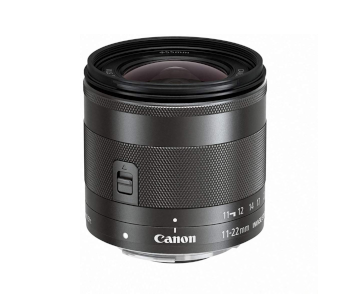 |
| Canon EF-M 11-22mm f/4-5.6 IS STM |
| 4.3/5.0 |
| Viewing angles: 102° 10′ to 63° 30′ |
| Image stabilization: Yes |
| Compact, well-rounded lens at a bargain price. |
| Check Amazon |
| Best Value |
|---|
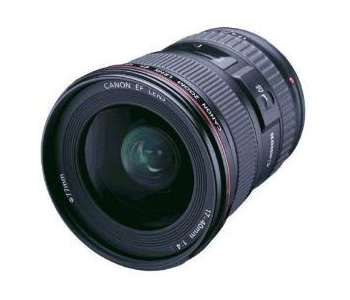 |
| Canon EF 17-40mm f/4L USM |
| 4.5/5.0 |
| Viewing angles: 104° to 57° 30′ |
| Image stabilization: No |
| Has a quick and silent autofocus. |
| Check Amazon |
| Top Pick |
|---|
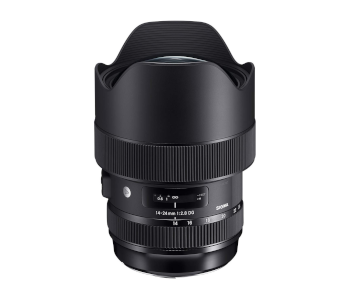 |
| Sigma 14-24mm F2.8 DG HSM Art |
| 4.7/5.0 |
| Viewing angles: 114.2° to 84.1° |
| Image stabilization: No |
| This has responsive zoom and focus rings. |
| Check Amazon |
Wide Angle Lenses for Canon Cameras Comparison Table
| Image | Product | Overall Rating | Image quality | Design | Features | Price |
|---|---|---|---|---|---|---|
 | Sigma 14-24mm F2.8 DG HSM Art | 4.7 | 4.8 | 4.6 | 4.7 | Check Price |
 | Canon EF 17-40mm f/4L USM | 4.5 | 4.6 | 4.5 | 4.5 | Check Price |
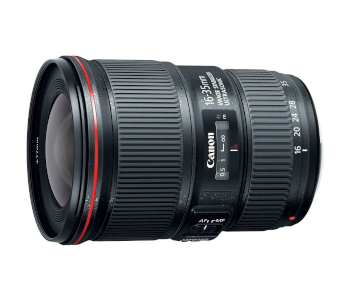 | Canon EF 16-35mm f/4L IS USM | 4.6 | 4.7 | 4.5 | 4.6 | Check Price |
 | Tamron 10-24mm F/3.5-4.5 Di-II VC HLD | 4.5 | 4.4 | 4.5 | 4.5 | Check Price |
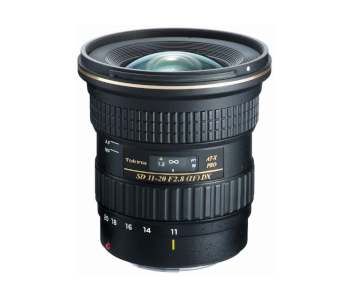 | Tokina ATXAF120DXC 11-20mm f/2.8 Pro DX | 4.3 | 4.5 | 4.0 | 4.3 | Check Price |
 | Canon EF-M 11-22mm f/4-5.6 IS STM | 4.3 | 4.3 | 4.4 | 4.3 | Check Price |
1. Best Overall – Sigma 14-24mm F2.8 DG HSM Art
Editor’s Rating: 4.7/5
Sigma is the best third-party lens manufacturer in the world, and having an ultra-wide that beats many of Canon’s own models is a testament to their quality. The DG HSM Art impresses with its sharpness and overall performance across focal lengths and aperture sizes. It’s great for landscape photographers looking to capture clear vistas but doesn’t disappoint for wide-angle close-ups either.
Overview of Features
Sigma’s lens combines a squat frame with noticeable heft. At 2.5 pounds, it isn’t the lightest model around, but it’s still portable. The build quality is excellent – the focus and zoom rings are rubberized for a better grip and respond to slight turning precisely. This is a sealed lens, so you can combine it with an equally rugged Canon camera and shoot in unforgiving weather.
We were impressed with the DG HSM Art’s versatility. Its minimum focus distance is 10.2 inches, meaning you can portray close subjects like meals or pets and give the photo plenty of context. Switching things up to landscape photography at smaller f numbers yields excellent results with minimal if any chromatic aberration.
Even though it performs well at most settings, the DG HSM Art shines when used with apertures between f/4 and f/8 regardless of focal length. Images taken with it are razor-sharp with only minimal softness applied to the edges at f numbers as small as f/22. You should avoid scenes where the sun is directly in front of it due to considerable flaring, but the DG HSM Art is otherwise capable of handling most lighting.
What We Didn’t Like
The DG HSM Art is prone to vignetting when zoomed out all the way and at f/2.8. You’ll want to increase the focal length or lower the f-number a step for optimum results. There’s also the matter of barrel distortion that warps straight lines towards the edges. The solution is to either shoot RAW files and correct this in post or avoid using the 14mm setting when a lot of lines are present in the shot.
| Tech Specs |
|---|
| Dimensions: 3.8 x 3.8 x 5.3 |
| Weight: 2.5 lbs. |
| Minimum focal length: 14mm |
| Maximum focal length: 24mm |
| Maximum aperture: f/2.8 |
| Minimum aperture: f/22 |
| Minimum focus distance: 10.2 in. |
| Viewing angles: 114.2° to 84.1° |
| Image stabilization: No |
| The Pros |
|---|
| Remarkable sharpness |
| Excellent build quality and weather sealing |
| Responsive zoom and focus rings |
| No chromatic aberration |
| The Cons |
|---|
| Visible vignetting at certain settings |
| Noticeable barrel distortion when zoomed out |
2. Best Value – Canon EF 17-40mm f/4L USM
Editor’s Rating: 4.5/5
The venerable EF 17-40mm f/4L USM has been around for more than a decade and is still going strong. It’s the lightest model in Canon’s L series and has gone down in price so much that it’s worth picking up even if you don’t currently need a wide angle lens. Use it as a general-purpose workhorse on an APS-C model or take beautiful landscapes with your full-frame Canon. Whichever camera you use it with, this lens is an incredible investment.
Overview of Features
We love how light and compact the EF 17-40mm f/4L USM is. It doesn’t extend while zooming as all the parts move internally. The lens is weather-sealed, but you need to attach a filter to complete the process. It comes with a soft carrying pouch and a small hood that reduces glare. Canon did a great job in designing the rings as well since they turn smoothly and are easy to grip even with wet hands.
The autofocus on the EF 17-40mm f/4L USM is quick and silent, thanks to its USM motor. You’ll want to avoid low-light situations due to the moderately fast performance an aperture of f/4 brings, but the autofocus is quick to snap to subjects under better circumstances. The aperture’s blades improve blur at high f numbers and make the EF 17-40mm f/4L USM a good choice if you care for close-range portraits with large margins.
There’s some detail loss at the edges, but that’s to be expected. Chromatic aberration is present but manageable and becomes clearly visible only with trying subjects like leafless tree branches. Barrel distortion is an issue at the 17mm end while there’s a slight pincushion effect when zoomed in all the way. 24mm is the sweet spot, so stick to it for the best quality.
What’s Bad About It?
The EF 17-40mm f/4L USM lacks sharpness. It’s noticeably better than your kit lens, but its image quality isn’t consistent and falls off as you approach the corners at 17mm. The hood you get with the lens is large and not very useful. It takes up a lot of space, too, so you’re better off leaving it at home.
| Tech Specs |
|---|
| Dimensions: 3.3 x 3.3 x 3.8 in. |
| Weight: 1.1 lbs. |
| Minimum focal length: 17mm |
| Maximum focal length: 40mm |
| Maximum aperture: f/4 |
| Minimum aperture: f/22 |
| Minimum focus distance: 11 in. |
| Viewing angles: 104° to 57° 30′ |
| Image stabilization: No |
| The Pros |
|---|
| Excellent value for the money |
| Responsive adjustment rings |
| Quick and silent autofocus |
| Versatile focal length |
| The Cons |
|---|
| Comes with low-quality hood |
| Images shot at 17mm lose a lot of detail in corners |
3. Canon EF 16-35mm f/4L IS USM
Editor’s Rating: 4.6/5
The lenses mentioned so far do well when your camera is mounted on a tripod, but what about situations when you’re forced to shoot with camera in-hand? That’s when you turn to the EF 16-35mm f/4L IS USM, another champ from the L line. It has internal image stabilization that ensures shaky hands don’t get in the way of award-winning photos. The lens also copes well with detail loss and color fringing. Plus, it’s built to Canon’s high standards while being easy to manage.
Overview of Features
The EF 16-35mm f/4L IS USM looks and feels similar to our value pick. It’s slightly heavier and longer but still within compact territory. The focus ring is wide and easy to adjust when wearing gloves, a real possibility as the lens holds up in bad weather. Special care has been given to minimizing unwanted light refraction as the lens is finished with Super Spectra coating and contains two Ultra-low Dispersion elements.
The inclusion of image stabilization makes the EF 16-35mm f/4L IS USM a tempting buy for cityscape and portrait photographers. If you pair it with a Canon camera that supports stabilization while panning, the lens will recognize the movement and respond accordingly. There’s a switch that goes from auto to manual focusing, but leaving it on auto produces excellent results as the autofocus spends little time hunting.
All the coating and dispersion-lowering tech results in outstanding color fringe mitigation. Purple or green fringes are a rare sight and negligible if present. Vignetting is only noticeable at 16mm and all but gone as you keep zooming. The EF 16-35mm f/4L IS USM handles both barrel and pincushion distortions better than its cheaper cousin. Finally, it’s able to produce creamy bokeh at high f numbers thanks to nine blades on the aperture.
Are There Drawbacks?
The only major complaint we have about this lens is a low maximum aperture. If you often work in dim light, consider the EF 16-35mm f/2.8L III USM. Its maximum aperture is f/2.8, but that comes at a hefty price increase. The image stabilization is great while it works. It’s the component most likely to suffer a malfunction, forcing you to replace the lens if IS matters to you.
| Tech Specs |
|---|
| Dimensions: 3.3 x 3.3 x 4.4 in. |
| Weight: 1.4 lbs. |
| Minimum focal length: 16mm |
| Maximum focal length: 35mm |
| Maximum aperture: f/4 |
| Minimum aperture: f/22 |
| Minimum focus distance: 11 in. |
| Viewing angles: 108° 10′ to 63° |
| Image stabilization: Yes |
| The Pros |
|---|
| Versatile image stabilization |
| Handles color fringing well |
| Quick autofocus |
| Produces lovely bokes |
| The Cons |
|---|
| Image stabilization can stop working |
| Not the best choice for low-light photography |
4. Tamron 10-24mm F/3.5-4.5 Di-II VC HLD
Editor’s Rating: 4.5/5
Do you have shaky hands but lack the budget for an L-series Canon lens? Tamron makes the 10-24mm F/3.5-4.5 Di-II VC HLD, a worthy alternative when image stabilization and silent yet responsive autofocus are concerned. The lens features excellent sharpness at its center and on the edges alike. It’s small, a pleasure to shoot with, and reasonably priced to boot.
Overview of Features
The first thing you’ll notice when using the 10-24mm F/3.5-4.5 Di-II VC HLD is how light it is. While its components are mostly plastic, don’t assume that the build quality is lackluster. The front and back glass has an assortment of fringe-reducing coatings, and the zoom ring is wide. The lens extends an additional 0.4 inches when you zoom to 24mm.
There are two noteworthy hardware features designated by the VC and HLD in the lens’ name. VC stands for Vibration Control and is a variety of image stabilization that reduces camera shake on par with Canon’s native lenses. HLD is a type of drive motor that handles the autofocus. It brings subjects into focus quickly and silently. Moreover, the motor lets you make adjustments without having to switch to manual.
We were most satisfied with the 10-24mm F/3.5-4.5 Di-II VC HLD’s sharpness. Central parts of an image remain detailed across the board while edges experience detail loss on only the highest aperture values. Distortion is present at both zoom extremes, but you can remove it with programs like Lightroom. You won’t have to deal with chromatic aberration unless you torture the lens with scenes that contain many small contrasting elements.
What We Didn’t Like
You’ll want to avoid having the sun in your photos as the 10-24mm F/3.5-4.5 Di-II VC HLD has pronounced flaring. It comes with a petal-shaped hood that doesn’t fix the problem. Tamron says that the lens works with all Canon APS-C cameras with an EF mount. It has autofocus issues with some older models, though.
| Tech Specs |
|---|
| Dimensions: 3.3 x 3.3 x 3.3 in. |
| Weight: 15.5 oz. |
| Minimum focal length: 10mm |
| Maximum focal length: 24mm |
| Maximum aperture: f/3.5 to 4.5 |
| Minimum aperture: f/22 to 29 |
| Minimum focus distance: 9.4 in. |
| Viewing angles: 108° 44′ to 60° 2′ |
| Image stabilization: Yes |
| The Pros |
|---|
| Silent autofocus with quick manual switching |
| Above-average sharpness |
| Small and light |
| Effective vibration reduction |
| The Cons |
|---|
| Unreliable autofocus when used with select older cameras |
| Pronounced lens flares |
5. Tokina ATXAF120DXC 11-20mm f/2.8 Pro DX
Editor’s Rating: 4.3/5
Shooting in low light is a challenge made easier with a fast lens. Tokina’s ATXAF120DXC 11-20mm f/2.8 Pro DX has a maximum aperture of f/2.8, which makes it a fine choice for dimly-lit scenes. It also has a good handle on sharpness drop-off and vignetting. There are a few quirks to consider, but this is the lens to get if you’re aiming for speed at an accessible price.
Overview of Features
The ATXAF120DXC 11-20mm f/2.8 Pro DX won’t be winning any design awards. It has a distinctly 90s aesthetic complete with pronounced knurling on the adjustment rings and a scaled-up front. We did like the focus ring as it’s easy to grab, and you can switch from auto to manual by pulling it back. Much more intuitive than looking for the switch when you’re in a pinch.
This is another lens that produces uniformly sharp images. The drop in quality between a photo’s center and edge is most noticeable at min and max aperture. Even so, they’re not problematic. Neither is vignetting, which falls well within acceptable limits even at 11mm. Vignetting Is even less pronounced if you switch to JPEG. The ATXAF120DXC 11-20mm f/2.8 Pro DX maintains a solid amount of detail as you approach 20mm with expected drops at minimum aperture levels.
Barrel distortion was an issue with our overall winner. You can see some at 11mm when using the ATXAF120DXC 11-20mm f/2.8 Pro DX, but it is much less pronounced.
What’s Bad About It?
The autofocus isn’t as snappy as that of other models on review. Worse yet, the motor is noisy, making Tokina’s lens a bad choice for filmmakers and photographers who don’t want to draw attention to themselves. This is a lens intended for APS-C cameras. Mounting some lenses with the same restriction onto full-frame cameras can produce good results, but this one is usable only at 20mm.
| Tech Specs |
|---|
| Dimensions: 3.5 x 3.5 x 3.6 in. |
| Weight: 1.2 lbs. |
| Minimum focal length: 11mm |
| Maximum focal length: 20mm |
| Maximum aperture: f/2.8 |
| Minimum aperture: f/22 |
| Minimum focus distance: 11 in. |
| Viewing angles: 104.34° to 72.42° |
| Image stabilization: No |
| The Pros |
|---|
| Fast lens at an accessible price |
| Handles vignetting better than more e expensive models |
| Intuitive focus switching |
| Good detail retention on edges |
| The Cons |
|---|
| Loud and unresponsive autofocus |
| Not suitable for full-frame cameras |
6. Best Budget Option – Canon EF-M 11-22mm f/4-5.6 IS STM
Editor’s Rating: 4.3/5
Most of the lenses discussed so far would make smaller cameras like the Canon EOS M6 Mark II front-heavy. That’s why owners of compact Canon models need a light, reliable, and stable wide angle lens like the EF-M 11-22mm f/4-5.6 IS STM. It’s a versatile lens you can use for anything from macros to landscapes. Add solid build quality and image stabilization, and you’ve got a great performer for an amazing price.
Overview of Features
The EF-M 11-22mm f/4-5.6 IS STM was designed specifically for smaller Canon cameras compatible with the EF-M mount. Its small frame and a mere 8 ounces make the lens a welcome accessory in any photographer’s bag. You’ll need one since the lens doesn’t come with a pouch, or a protective hood either. However, the EF-M 11-22mm f/4-5.6 IS STM makes up for that with its superb metal construction and fixed filter thread.
Onboard image stabilization equates to three stops and is accompanied by reliable autofocus. Its performance is acceptable regardless of light intensity, allowing you to snap clear images with little time wasted on hunting. The motor is quiet enough not to ruin establishing shots. The minimum focus point is 5 inches, close enough for macro shots of larger insects or minerals.
You’ll love the EF-M 11-22mm f/4-5.6 IS STM if you focus on landscape and general travel photography. Differences in sharpness across the frame are minimal, and color fringing becomes noticeable only in unforgiving situations. Lens flares are a rare occurrence, so feel free to go for the coveted sun star look if the composition warrants it.
Are There Drawbacks?
The focus ring is wide but has a slim ridged portion that makes rapid adjustments trickier. It doesn’t come to a stop at endpoints either, forcing you to guess when you’ve reached infinity. There’s significant vignetting when shooting at 11mm. Switching from RAW to JPEG helps, as does post-processing, but the difference in light between the center and edges remains visible.
| Tech Specs |
|---|
| Dimensions: 2.4 x 2.4 x 2.3 in. |
| Weight: 7.8 oz. |
| Minimum focal length: 11mm |
| Maximum focal length: 22mm |
| Maximum aperture: f/4 to 5.6 |
| Minimum aperture: f/22 to 32 |
| Minimum focus distance: 5.9 in. |
| Viewing angles: 102° 10′ to 63° 30′ |
| Image stabilization: Yes |
| The Pros |
|---|
| Compact, well-rounded lens at a bargain price |
| Effective image stabilization |
| Quiet autofocus |
| Suitable for macro as well as outdoor photography |
| The Cons |
|---|
| Pronounced vignetting |
| Fiddly focus ring |
Contents
- Wide Angle Lenses for Canon Cameras Comparison Table
- 1. Best Overall – Sigma 14-24mm F2.8 DG HSM Art
- Overview of Features
- What We Didn’t Like
- 2. Best Value – Canon EF 17-40mm f/4L USM
- Overview of Features
- What’s Bad About It?
- 3. Canon EF 16-35mm f/4L IS USM
- Overview of Features
- Are There Drawbacks?
- 4. Tamron 10-24mm F/3.5-4.5 Di-II VC HLD
- Overview of Features
- What We Didn’t Like
- 5. Tokina ATXAF120DXC 11-20mm f/2.8 Pro DX
- Overview of Features
- What’s Bad About It?
- 6. Best Budget Option – Canon EF-M 11-22mm f/4-5.6 IS STM
- Overview of Features
- Are There Drawbacks?

